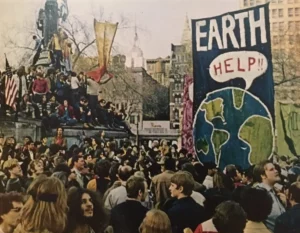
LIKE THE MOON ITSELF…
Like the moon itself, the ‘Reduce Reuse Recycle Symbol,’ widely known as the recycling symbol, seems to predate our collective memory. In fact, some may argue that the iconic three arrows forming a continuous loop are as universal today as ancient religious symbols like the Yin and Yang or the Cross. All the more startling, then, to learn that its history only dates back to the bell-bottom, disco-shaking 70s. But how did it happen? Let’s take a look!
Origin Story

HE HAS ONE, AND SO DOES THE RECYCLING SYMBOL
Who doesn’t like a good origin story? Wolverine has one, and so does the Reduce Reuse Recycle Symbol, which dates back to the early 70s. A senior at the University of Southern California, Gary Anderson submitted a design for a contest sponsored by the Container Corporation of America. The purpose? To create a symbol, easy on the eyes and universally understood, that would encourage recycling.

A Green Movement
But Anderson’s design didn’t just win a local contest; it became the face of the environmental movement. Spurred by events like the first Earth Day in 1970, as the 70s progressed a great deal of concern about pollution and waste grew, and the Reduce Reuse Recycle Symbol became a rallying point for conservationists. Not simply a logo, it was a call to action.

FIRST EARTH DAY: APRIL 22, 1970
Reduce, Reuse, Recycle Symbol Going Global
With its straightforward design and unmistakable message, the recycling symbol quickly gained traction and became a universal representation of environmental consciousness worldwide. Anderson’s design transcended cultural barriers, and its adoption by the recycling movement propelled it into the public consciousness, appearing on packaging, products, posters and recycling bins worldwide.
By the 1980s, Anderson’s symbol was synonymous with environmentalism. Now well-entrenched in public awareness, artists and designers incorporated the symbol into their works to further environmental activism and consciousness.

STARRY NIGHT IN RECYCLED ART
The 1980s also saw the rise of many advocacy groups and movements that promoted recycling and waste reduction. These grassroots efforts were instrumental in raising awareness and encouraging, not only individuals, but communities to participate in recycling programs. So that by the end of the decade, this relatively obscure logo had transitioned into a universally recognized icon of conservationism.
Backlash
Although widely recognized, the recycling symbol has received backlash from some critics who argue that its overuse has led to a false sense of environmental responsibility, i.e. people who may mistakenly believe that simply finding the logo on a product makes it environmentally friendly. Additionally, many critics highlight the inadequacies of recycling alone in addressing the larger challenges of waste management and dwindling resources, calling for a more holistic approach that focuses on reduction and reuse over recycling.
To address these concerns, environmental organizations and regulatory bodies worked towards educating both manufacturers and consumers about the correct usage of the symbol. Through initiatives like certification programs and transparent packaging guidelines, their efforts helped reinforce the symbol’s intended message and upheld its association with sincere eco-friendly efforts.
Final Thoughts
As we look to the future, the ‘Reduce Reuse Recycling Symbol’—aka, the recycling symbol—remains an ever constant visual sign for sustainability. Nevertheless, the challenges of a new century do require a more subtle, comprehensive approach to environmental issues.
Promoting a circular economy, emphasizing the importance of reducing consumption, repairing, upcycling—all there are major efforts underway to enlarge the symbol’s reach and meaning beyond simply recycling.
At eAsset Solutions, we believe firmly in adopting a holistic, comprehensive approach to reducing, not only e-waste, but all waste. Our work in the tech sphere, with special emphasis on data destruction, is our company’s contribution to keeping the torch aflame, lit so many years ago by pioneers like Gary Anderson and the early environmentalists, as we move into the future.
If you have any questions about our e-waste or gym equipment pickups, please do not hesitate and call us at 703-534-5865 or reach out to us online.




